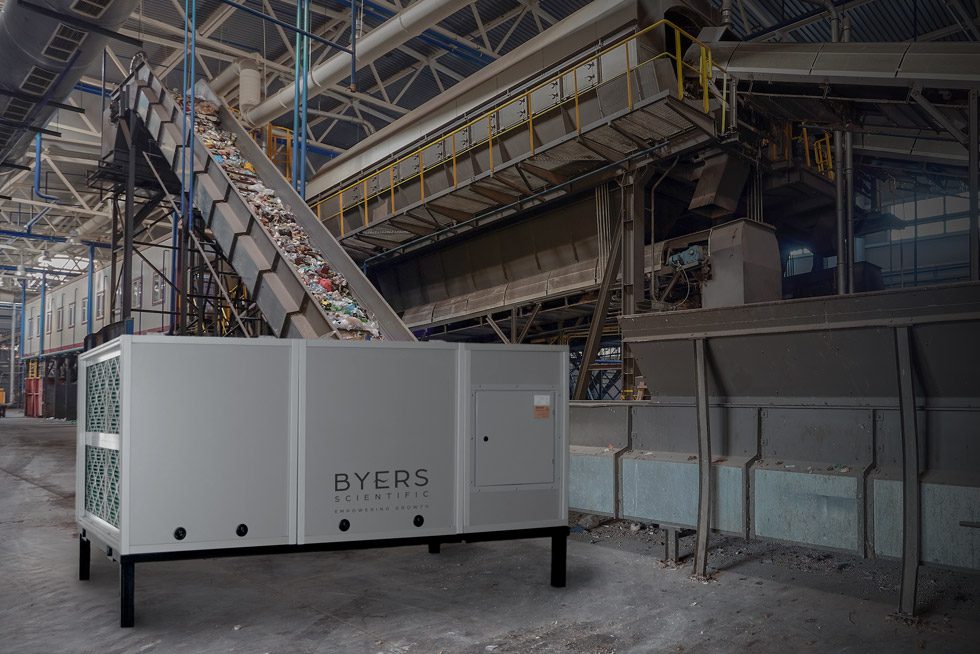Dust and odor emissions are common issues that need to be addressed by Material Recovery Facility (MRF) managers as they take on multiple waste streams of various types to be stockpiled and shipped back to recycling markets for resale. Because of these multiple waste streams, when discussing MRF odor control, it is important to consider that there can be a variety of problematic emissions present that need to be properly mitigated.
Typical industrial odor control techniques, such as the misting of masking agents to attempt to cover-up the smell of waste, are expensive, potentially harmful to the environment and ultimately do not provide an effective solution to the odor problem. MRF odor control and dust suppression is much more complicated than simple roof exhaust systems or masking agents. Here are three ways Byers Scientific is revolutionizing MRF odor control.
Comprehensive Smart MRF Odor Control Systems
As MRFs are prone to issues with dust and odor, the MT-6™ system is specifically designed to mitigate both through the use of a Hi-Flo bag filter capable of holding 15+ pounds of dust along with a specially-selected activated carbon media targeting the most common odor compounds found in MRFs. While its combination of effectiveness and efficiency are unrivaled in the odor control industry, what makes the MT-6™ truly unique is that each system is equipped with Bolt-On™ Cloud-based SCADA functionality accessible anywhere, anytime via a dedicated client website allowing for real-time 24/7/365 operation, monitoring and reporting. More specifically, this innovative intelligent system empowers operators to access critical operational data for compliance purposes while enjoying the convenience of building operating schedules and maintenance procedures for their facility that can be controlled remotely using the power of IIoT.
Identifying Odor Compounds
The second way Byers Scientific is revolutionizing odor control for MRFs is by tailoring odor control techniques and equipment to the specific odor compounds identified at client facilities. As the industry sees a push for more and more recyclable materials as well as organics to be removed from landfills for composting or anaerobic digestion, odor profiles are quickly changing at MRFs which can prove to be problematic for traditional odor control strategies. Byers Scientific can help. The Byers Emissions Analysis division can take odor samples at the MRF facility and facilitate a third-party odor evaluation to help identify the types, strength and source(s) of the various odor compounds present allowing for a more targeted mitigation approach. Byers Scientific replaces the traditional wet finger in the air with hard science and data to ensure operators are taking appropriate measures to address MRF odors before they put a strain on critical community relationships.
Environmental Intelligence Monitoring
Environmental intelligence is the third way Byers Scientific is revolutionizing MRF odor control. Thanks to a strategic partnership with Envirosuite, Byers is able to offer real-time environmental and meteorological monitoring for MRF facilities. This industry-leading technology monitors ambient air with sensors and ultrasonic weather stations to help determine odor and emissions travel patterns. For example, mapping the direction of wind allows operators to identify the communities commonly downwind of their facility and utilizing Envirosuite reverse trajectory modeling allows operators to determine the true source of odor complaints, allowing for transparency and faster resolution. When an odor complaint is received, MRF operators can easily check the relevant operational, environmental and meteorological data to help validate or dispute the grievance.
It is no secret that MRF odor and emissions are challenging to manage as they are often unseen, elusive and subjective; however, the comprehensive and innovative approach taken by Byers Scientific empowers their clients to focus on operations not odor.
Contact us today to learn more.


